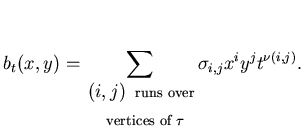Now let us come back to the Patchwork Theorem. It states that for
any convex triangulation ![]() of
of ![]() with integer vertices and a
distribution of signs at
vertices of
with integer vertices and a
distribution of signs at
vertices of ![]() there exists a nonsingular real algebraic
plane projective curve
there exists a nonsingular real algebraic
plane projective curve ![]() of degree
of degree ![]() such that the pair
such that the pair
![]() is homeomorphic to the pair
is homeomorphic to the pair
![]() constructed
as in Section 1, i. e. the result of projective
combinatorial patchworking.
constructed
as in Section 1, i. e. the result of projective
combinatorial patchworking.
In fact, a polynomial defining the curve can be presented quite explicitly.
Construction of Polynomials.
Given initial data ![]() ,
, ![]() ,
, ![]() and
and
![]() as in Section 1 and a
convex function
as in Section 1 and a
convex function ![]() certifying that the triangulation
certifying that the triangulation ![]() is
convex. Consider a one-parameter family of polynomials
is
convex. Consider a one-parameter family of polynomials

Then there exists ![]() such that
for any
such that
for any
![]()
A curve obtained by this construction is called a T-curve.
All real schemes of curves of degree ![]() and almost all real
schemes of curves of degree
and almost all real
schemes of curves of degree ![]() have been realized by the patchwork
construction described above. On the other hand, there exist real
schemes realizable by algebraic curves of some (high) degree, but not
realizable by T-curves of the same degree. Probably such a scheme can
be found even for degree
have been realized by the patchwork
construction described above. On the other hand, there exist real
schemes realizable by algebraic curves of some (high) degree, but not
realizable by T-curves of the same degree. Probably such a scheme can
be found even for degree ![]() or
or ![]() .
.
The construction of T-curves is a special case of more general patchwork construction, see [17] and [13]. In this generalization the patches are more complicated: they may be algebraic curves of any genus with arbitrary Newton polygon. Therefore the patches demand more care than above. This is why we restrict ourselves here to T-curves. However, even constructing T-curves it is useful to think in terms of blocks more complicated than a single triangle (made of several triangles).
The rest of the paper is devoted to applications of the patchwork construction.